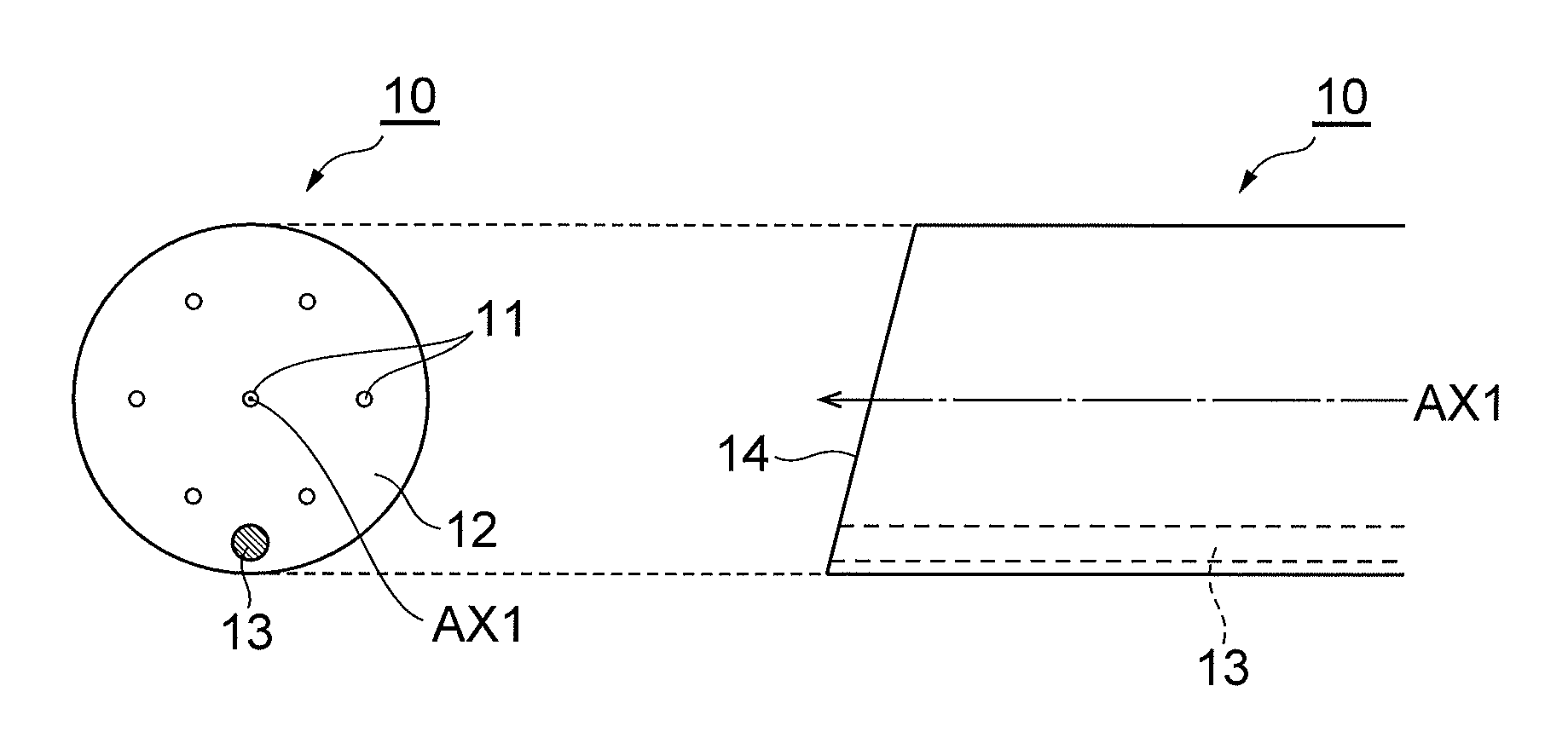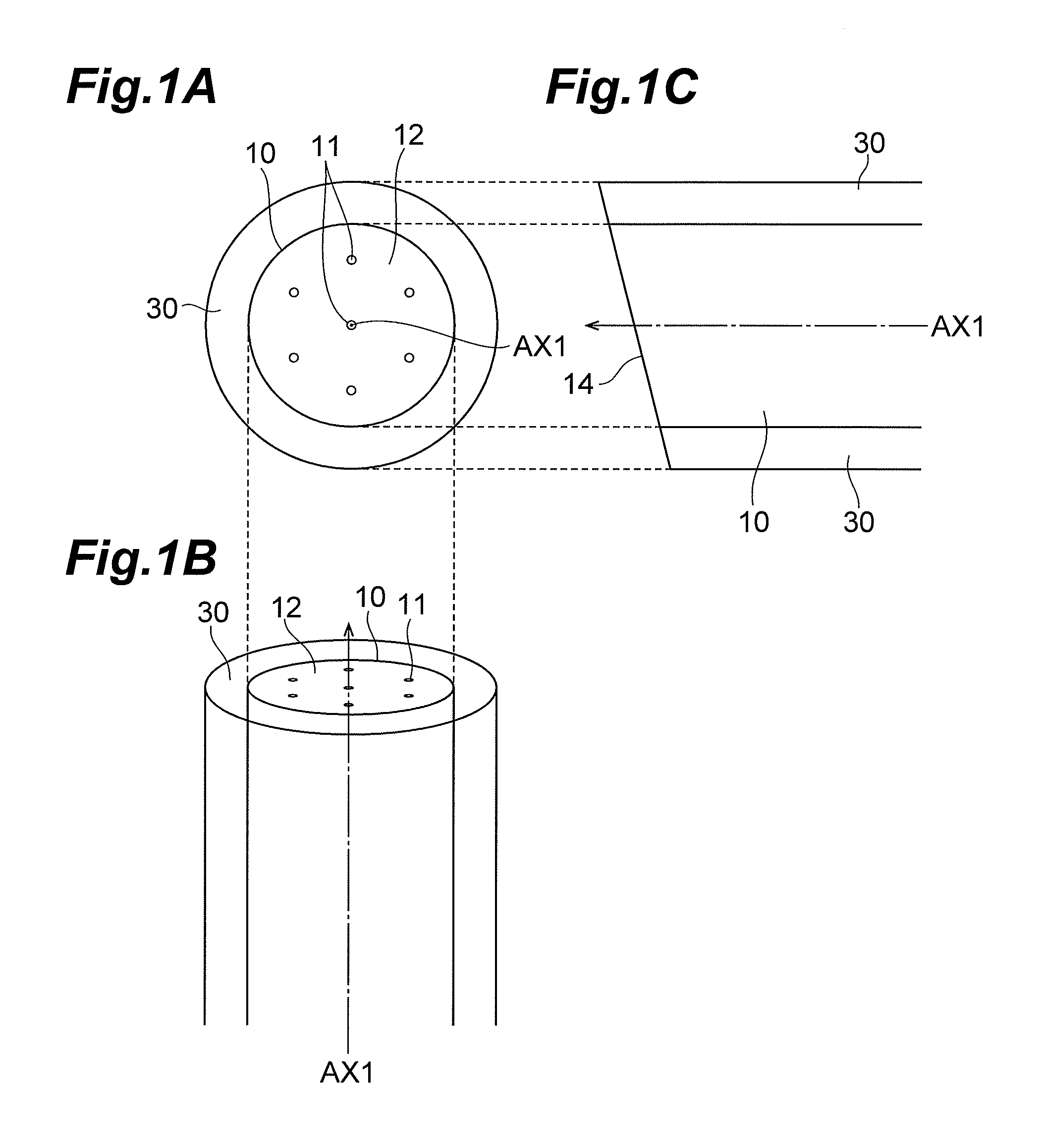Multi-core optical fiber interconnection structure and method for manufacturing multi-core optical fiber interconnection structure
a multi-core optical fiber and interconnection structure technology, applied in the direction of optical elements, manufacturing tools, instruments, etc., can solve the problems of difficulty in applying the aforementioned pc coupling to each of the cores, and no conventional technology taking into account the reflection at the interconnection, so as to minimize the variation in the distance between pairs and minimize the variation in the loss of inter-core connection
- Summary
- Abstract
- Description
- Claims
- Application Information
AI Technical Summary
Benefits of technology
Problems solved by technology
Method used
Image
Examples
first embodiment
[0027]FIGS. 1A to 1C are drawings showing a configuration of one multi-core optical fiber (first multi-core optical fiber) 10 which can be applied to a multi-core optical fiber interconnection structure 1 according to the first embodiment. FIG. 1A is a view of the multi-core optical fiber 10 from a direction along a central axis AX1. FIG. 1B and FIG. 1C are views of the multi-core optical fiber 10 from two directions normal to the direction along the central axis AX1 and perpendicular to each other.
[0028]The multi-core optical fiber 10 has a plurality of cores 11 extending along the central axis AX1, in a common cladding 12. Each core 11 has the refractive index higher than that of the cladding 12 and can guide light. In the example shown in FIGS. 1A to 1C, one core 11 exists at the center in a circular section normal to the central axis AX1 of the multi-core optical fiber 10, and six cores 11 exist at equal intervals on the circumference of a circle centered at the central core 11....
second embodiment
[0038]FIGS. 3A and 3B are drawings showing a configuration of one multi-core optical fiber (first multi-core optical fiber) 10 applied to a multi-core optical fiber interconnection structure 2 according to the second embodiment. FIG. 3A is a view of the multi-core optical fiber 10 from a direction along the central axis AX1. FIG. 3B is a view of the multi-core optical fiber 10 from a direction normal to the central axis AX1.
[0039]The multi-core optical fiber 10 has a plurality of cores 11 extending along the central axis AX1, in a common cladding 12. Each core 11 has the refractive index higher than that of the cladding 12 and can guide light. In the example shown in FIGS. 3A and 3B, one core 11 exists at the center in a circular section normal to the central axis AX1 of the multi-core optical fiber 10 and six cores 11 exist at equal intervals on the circumference of a circle centered at the central core 11. Namely, the seven cores 11 are arranged at respective grid points of a tria...
modification examples
[0050]The present invention does not have to be limited to the above embodiments but can be modified in many ways. For example, the seven cores were arranged in the triangle grid pattern in the first and second embodiments, but the number of cores and the core arrangement in the multi-core optical fibers do not have to be limited to this configuration. The number of cores may be not more than 6 or not less than 8. The core arrangement may be determined from a variety of forms, e.g., arrangement of a rectangular grid pattern, arrangement on the same circumference, and so on.
[0051]In the second embodiment, one marker was the one that can be optically recognized on the end face, but the number, form, and arrangement of marker do not have to be limited to this configuration. A variety of modification examples can be contemplated; e.g., two or more markers are arranged so as to facilitate formation of the slant end faces.
[0052]The first and second embodiments were the examples to connect...
PUM
| Property | Measurement | Unit |
|---|---|---|
| angle | aaaaa | aaaaa |
| slant angles | aaaaa | aaaaa |
| slant angle | aaaaa | aaaaa |
Abstract
Description
Claims
Application Information
 Login to View More
Login to View More - R&D
- Intellectual Property
- Life Sciences
- Materials
- Tech Scout
- Unparalleled Data Quality
- Higher Quality Content
- 60% Fewer Hallucinations
Browse by: Latest US Patents, China's latest patents, Technical Efficacy Thesaurus, Application Domain, Technology Topic, Popular Technical Reports.
© 2025 PatSnap. All rights reserved.Legal|Privacy policy|Modern Slavery Act Transparency Statement|Sitemap|About US| Contact US: help@patsnap.com



